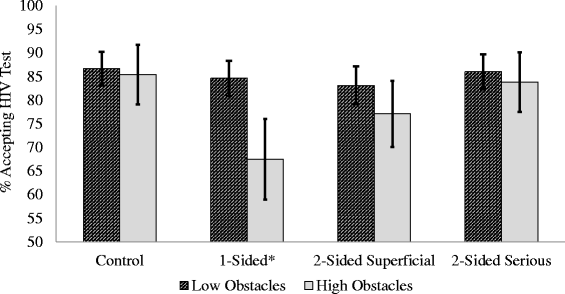The effects of HIV testing advocacy messages on test acceptance: a randomized clinical trial
- PMID: 25374047
- PMCID: PMC4243315
- DOI: 10.1186/s12916-014-0204-4
The effects of HIV testing advocacy messages on test acceptance: a randomized clinical trial
Abstract
Background: Nearly 1 in 5 people living with HIV in the United States are unaware they are infected. Therefore, it is important to develop and evaluate health communication messages that clinicians can use to encourage HIV testing.
Methods: The objective was to evaluate health communication messages designed to increase HIV testing rates among women and evaluate possible moderators of message effect. We used a randomized four-arm clinical trial conducted at urban community outpatient health clinics involving 1,919 female patients, 18 to 64 years old. The four health message intervention groups were: i) information-only control; ii) one-sided message describing the advantages of HIV testing; iii) two-sided message acknowledging a superficial objection to testing (i.e., a 20 minute wait for results) followed by a description of the advantages of testing; and iv) two-sided message acknowledging a serious objection (i.e., fear of testing positive for HIV) followed by a description of the advantages of testing. The main outcome was acceptance of an oral rapid HIV test.
Results: Participants were randomized to receive the control message (n = 483), one-sided message (n = 480), two-sided message with a superficial objection (n = 481), or two-sided message with a serious objection (n = 475). The overall rate of HIV test acceptance was 83%. The two-sided message groups were not significantly different from the controls. The one-sided message group, however, had a lower rate of testing (80%) than the controls (86%) (OR, 0.66; 95% CI, 0.47-0.93; P = 0.018). "Perceived obstacles to HIV testing" moderated this effect, indicating that the decrease in HIV test acceptance for the one-sided message group was only statistically significant for those who had reported high levels of obstacles to HIV testing (OR, 0.36; 95% CI, 0.19-0.67; P = 0.001).
Conclusions: None of the messages increased test acceptance. The one-sided message decreased acceptance and this effect was particularly true for women with greater perceived obstacles to testing, the very group one would most want to persuade. This finding suggests that efforts to persuade those who are reluctant to get tested, in some circumstances, may have unanticipated negative effects. Other approaches to messaging around HIV testing should be investigated, particularly with diverse, behaviorally high-risk populations.
Trial registration: Clinicaltrials.gov Identifier: NCT00771537. Registration date: October 10. 2008.
Figures
Similar articles
-
Announcing the availability of oral HIV self-test kits via text message to increase HIV testing among hard-to-reach truckers in Kenya: a randomized controlled trial.BMC Public Health. 2019 Jan 3;19(1):7. doi: 10.1186/s12889-018-6345-1. BMC Public Health. 2019. PMID: 30606161 Free PMC article. Clinical Trial.
-
Predictors of provider- initiated HIV testing and counseling refusal by outpatient department clients in Wolaita zone, Southern Ethiopia: a case control study.BMC Public Health. 2016 Aug 12;16:783. doi: 10.1186/s12889-016-3452-8. BMC Public Health. 2016. PMID: 27519262 Free PMC article.
-
Integration of routine rapid HIV screening in an urban family planning clinic.J Midwifery Womens Health. 2011 Jul-Aug;56(4):395-399. doi: 10.1111/j.1542-2011.2011.00031.x. Epub 2011 May 31. J Midwifery Womens Health. 2011. PMID: 21733112
-
Messaging matters: achieving equity in the HIV response through public health communication.Lancet HIV. 2021 Jun;8(6):e376-e386. doi: 10.1016/S2352-3018(21)00078-3. Lancet HIV. 2021. PMID: 34087098 Free PMC article. Review.
-
Creating information messages for reducing patient distress during health care procedures.Patient Educ Couns. 1997 Mar;30(3):247-55. doi: 10.1016/s0738-3991(96)00974-3. Patient Educ Couns. 1997. PMID: 9104381 Review.
Cited by
-
Factors Associated With the Intention to Receive the COVID-19 Vaccine: Cross-sectional National Study.JMIR Public Health Surveill. 2022 Nov 14;8(11):e37203. doi: 10.2196/37203. JMIR Public Health Surveill. 2022. PMID: 36219842 Free PMC article.
-
The effects of message framing and healthcare provider recommendation on adult hepatitis B vaccination: A randomized controlled trial.Prev Med. 2019 Oct;127:105798. doi: 10.1016/j.ypmed.2019.105798. Epub 2019 Aug 9. Prev Med. 2019. PMID: 31404569 Free PMC article. Clinical Trial.
-
A need for implementation science to optimise the use of evidence-based interventions in HIV care: A systematic literature review.PLoS One. 2019 Aug 19;14(8):e0220060. doi: 10.1371/journal.pone.0220060. eCollection 2019. PLoS One. 2019. PMID: 31425524 Free PMC article.
-
Demand creation for HIV testing services: A systematic review and meta-analysis.PLoS Med. 2023 Mar 21;20(3):e1004169. doi: 10.1371/journal.pmed.1004169. eCollection 2023 Mar. PLoS Med. 2023. PMID: 36943831 Free PMC article.
-
The Effectiveness of Social Marketing Interventions to Improve HIV Testing Among Gay, Bisexual and Other Men Who Have Sex with Men: A Systematic Review.AIDS Behav. 2019 Sep;23(9):2273-2303. doi: 10.1007/s10461-019-02507-7. AIDS Behav. 2019. PMID: 31006047 Free PMC article.
References
-
- Centers for Disease Control and Prevention: Monitoring Selected National HIV Prevention and Care Objectives by Using HIV Surveillance Data – United States and 6 U.S. Dependent Areas – 2010. HIV Surveillance Supplemental Report 2012, 17(No. 3). [http://www.cdc.gov/hiv/topics/surveillance/resources/reports/]. Accessed June 25, 2012.
-
- Centers for Disease Control and Prevention: HIV Testing Trends in the United States, 2000–2011. [http://www.cdc.gov/hiv/pdf/testing_trends.pdf]. Accessed June 15, 2013.
-
- Centers for Disease Control and Prevention Number of persons tested for HIV – United States, 2002. MMWR. 2004;53:1110–1113. - PubMed
-
- U.S. Department of Health and Human Services: Healthy People 2020. Washington, DC: [http://www.healthypeople.gov/2020/topics-objectives/topic/hiv/objectives...]. Accessed December 26, 2013.
-
- Centers for Disease Control and Prevention: HIV/AIDS Testing. [http://www.cdc.gov/hiv/basics/testing.html]. Accessed December 26, 2013.
Publication types
MeSH terms
Associated data
Grants and funding
LinkOut - more resources
Full Text Sources
Other Literature Sources
Medical



